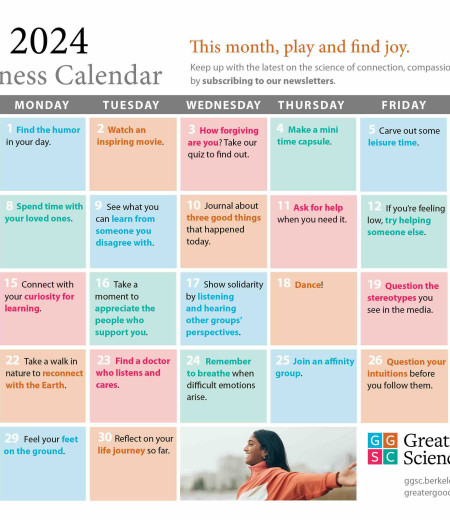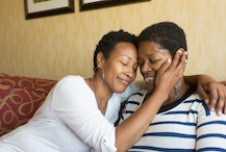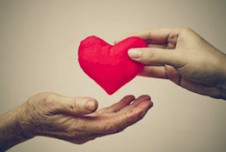There is plenty of science to convince us that social connection is key to well-being. But relationships are complicated, bringing good and bad into our lives. This year’s top insights speak to the practical forces that unite us or divide us—both in intimate relationships and in our communities. They offer some hints about how to overcome anger or loneliness, and help explain why it’s so hard to make friends and offer them emotional support. They demonstrate the psychological forces that lead to conflict and the kinds of environments that promote greater generosity.
All of these insights remind us of the interplay between our inner lives and our social conditions. Ways we might take care of ourselves, like practicing mindfulness and getting good sleep, have implications down the line for our relationships. And the type of neighborhood and culture we live in, in turn, influence our own well-being.
This year’s top insights from the science of a meaningful life move from our most private emotions to the ways different groups of Americans relate to each other. They won’t solve all of our social problems—but we hope this list of discoveries will help you to better understand yourself and the people around you.
It takes 120 hours (or more) to make a good friend

A great deal of research has investigated the tricky realms of parenting and romantic relationships. Yet studies on friendship—which can offer so much joy and meaning in life—remain less common.
This year, University of Kansas researcher Jeffrey A. Hall helped demystify the process of friendship-building in a study published in the Journal of Social and Personal Relationships. It’s the first to explore how many hours it takes for an acquaintance to become a friend.
Hall surveyed 112 college students every three weeks during their first nine weeks at a Midwestern university. He also gave a one-time questionnaire to 355 American adults who had moved to a new city in the past six months. In these surveys, the newcomers picked a friend or two and reported how much time they spent together and how close the friendship became.
With this data, Hall was able to approximate how many hours it took for different levels of friendship to emerge:
- It took students 43 hours and adults 94 hours to turn acquaintances into casual friends.
- Students needed 57 hours to transition from casual friends to friends. Adults needed, on average, 164 hours.
- For students, friends became good or best friends after about 119 hours. Adults needed an additional 100 hours to make that happen.
How do you know if someone is destined to become your bestie or remain a polite acquaintance? Hall asked people what kind of activities they did with their friends, but there was no one clear path to intimacy. However, a different team of researchers discovered this year that they could predict which people were friends based on their brain activity. Friends, it seems, share not just secrets and hugs but similar neural responses to the world.
These findings offer hope—and a dash of perspective—to those of us feeling lonely and yearning to find our crowd.
“Making friends takes time,” Hall says. “Everyone wants to have friends, but you can’t have friends without making them.”
You’re not as good at empathy as you think you are

Do you consider yourself to be pretty good at identifying what other people are feeling? Well, don’t be too confident, suggest four recent studies.
One study, published in the Journal of Personality and Social Psychology, ran multiple experiments testing how accurately people gauged the feelings and thoughts of others. Some people were specifically instructed to try to walk in others’ shoes, while others were instead asked to do things like concentrate hard or imitate the expression on the other person’s face. The researchers found that the shoe-walkers did no better at accurately reading another person than any of the other groups—and, in some cases, they did worse.
In yet another recent study, researchers asked some participants to look at the face of a person who was watching an emotionally evocative video—and then guess the emotion in the video from the face of the watcher. Another group simply watched the video and tried to imagine how it would make a stranger feel. You might think that faces are an open book, but the people who tried to guess the emotion in the video from a watcher’s face were more often wrong than those who just watched the same video themselves.
In these studies, the most confident people were often the least accurate at empathizing. The problem is hubris—thinking we understand people better than we do and jumping to unwarranted conclusions. But there are ways to improve our empathic skills. Over the long term, we can work on developing our own self-awareness—since, in two other studies this year, more self-aware people were better at identifying the feelings of others.
In the meantime, we can better understand others—whether a spouse or someone on the other side of the political spectrum—if we simply ask them questions and listen carefully to the answers.
Mindfulness can help you manage your anger

All of us have probably lost our cool at one time or another—maybe yelling at the phone company or at a child who misbehaved. But these outbursts are rarely very effective, and they often leave us feeling ashamed and regretful.
How to handle anger better? Recent studies suggest mindfulness could help.
In a study published in Mindfulness, David DeSteno and his colleagues randomly assigned participants to either a three-week mindfulness course (training in breath and body awareness, open awareness of thoughts, and not judging experiences) or a control activity that involved solving cognitive puzzles, prior to bringing both groups into a lab. There they gave a talk—and then received a scathing review of their performance from an undercover research assistant in the audience. Afterwards, researchers asked them to make a condiment mixture for their critics to sample based on a few ingredients, including a very hot pepper sauce—a way to see how aggressive they would be.
The results? Those who’d practiced mindfulness meditation said they were just as angry as non-meditators…but they added significantly less hot sauce to the mix. Apparently, the meditators were more able to feel anger without lashing out.
Other recent studies support the idea that mindfulness can help us regulate our emotions amid social tension. In one, more mindful spouses were able to maintain lower blood pressure and greater heart rate variability—indicating better recovery from stressors—while discussing marital conflicts than people who were less mindful. Another found that more mindful people seemed to be less distressed when they were excluded by others, and their brains showed decreased activity in the ventrolateral prefrontal cortex, too—a pattern associated with exerting less cognitive control over emotional upsets.
These finding suggest that mindfulness could help us manage our anger better—not by suppressing it, but by staying cool while anger passes through us. That’s why DeSteno says that mindfulness meditation does “exactly what the developers of meditation hoped that it would do: increase ethical behavior by preventing people from inflicting harm on other people in a situation where that’s the normative response.”
Sleeplessness breeds loneliness

It’s been long known that when you’re feeling lonely, you may not sleep as well. But the opposite appears to be true, too: Poor sleep leads to loneliness.
In a recent study published in Nature Communications, researchers scanned people’s brains both after a normal night’s sleep and after a night of sleep deprivation. Participants watched videos of a stranger approaching them from a distance and pushed a button when they felt the stranger was getting uncomfortably close, while the researchers monitored what was happening in their brains.
After sleeping poorly, participants wanted the strangers to stop at a much greater distance than they did after a night of normal sleep, and their brains reflected a particular pattern: Circuits associated with social repulsion lit up, while circuits involved in theory of mind (our ability to gauge the intentions of others) diminished. This pattern suggests that poor sleep makes people want to avoid other people. Indeed, the poorly slept participants also reported feeling lonelier.
Then, the researchers took the experiment one step further: They asked other people to rate how lonely they thought participants felt by watching videotapes of them. Not only did the raters think the sleep-deprived ones looked lonelier—the raters were also less interested in interacting with them. This implies that poor sleep could lead to a vicious cycle of avoiding others and others avoiding us—a threat to our well-being.
As the researchers conclude, “People who come in contact with a sleep-deprived individual, even through a brief one-minute interaction, feel lonelier themselves as a result, indicating viral contagion of social isolation caused by sleep loss.”
Other studies have shown that healthy sleep affects our relationships by helping us better empathize with others, reduce our prejudices, modulate our anger, and be less susceptible to rejection. These new findings add to that science, demonstrating that a good night’s sleep can help prevent loneliness, too—in ourselves and in those around us.
Smartphones can make in-person interactions less enjoyable

As smartphones become ubiquitous, it seems like it’s becoming more and more socially acceptable to use them in different settings. But how does this affect our relationships with other people?
A study published in the Journal of Experimental Social Psychology investigated how smartphones influence in-person interactions by inviting over 300 people to share a meal with friends or family at a cafe. Some people kept their phones out next to them, while others turned their phones on silent and stowed them away. Afterward, they filled out surveys about their experience.
Ultimately, the people who dined without their phones felt less distracted and (in turn) enjoyed the meal more. They were also less bored and in a better mood. In a separate analysis, the same team of researchers pinged 123 students randomly during their daily life—to find out what they were doing, how they were feeling, and whether they were using their phones—and the same pattern appeared. People just didn’t enjoy socializing as much if they were on their phones.
“Phone use prevents individuals from fully engaging in the present moment,” the researchers write. “Despite their ability to connect us to others across the globe, phones may undermine the benefits we derive from interacting with those across the table.”
This seems to be true even for people who grew up with smartphones, like the college students in the study. In fact, another study published in Emotion this year suggests that well-being is declining among teens and that screen time may be to blame. A team of researchers led by Jean Twenge found that teens who spend more time on screens and less time on offline activities tend to have reduced well-being. And since 2012, the first year when a majority of Americans owned smartphones, the rise in screen time has gone hand in hand with decreases in teens’ self-esteem and satisfaction with life.
There was one hopeful finding in Twenge’s study, though: On an individual level, teens who spent more time interacting with friends online also spent more time with friends in-person. Our online and offline worlds are not always a zero-sum game—but maybe, as the first study suggests, it’s best not to combine them during the same meal.
Teen emotions really are jumbled

If you have any teenagers in your life, you’ve probably witnessed the emotional rollercoaster that is adolescence. But why is teen emotional life so rocky, and how is it different from our emotional experience at other ages?
In a study published in Psychological Science, researchers from Harvard and the University of Washington asked participants ages five to 25 to look at a series of unpleasant images, such as a baby crying, and rate how much they felt five negative emotions: angry, disgusted, sad, scared, and upset. Their scores were analyzed to see how often they experienced a certain emotion independently from the other four emotions.
Ultimately, the researchers found that adolescents tended to experience many emotions simultaneously—and that they differentiated them poorly. In other words, a teenager might consistently feel angry and sad together, indicating that it is difficult for her to distinguish between the two.
Adolescence is “a period of more murkiness in what emotions one is feeling,” explains lead author Erik Nook.
Emotion differentiation, the ability to know and accurately label distinct emotions in ourselves, is a sign of good mental health. Those with high emotion differentiation tend to use effective coping strategies in difficult situations instead of turning to unhealthy alternatives like aggression or alcohol.
Can teenagers improve their ability to differentiate emotions? Or do they just have to wait until adulthood when, the research suggested, people became better at it?
Another 2018 study published in Emotion found that teaching middle schoolers about their emotions—specifically, how they can get better at changing them with practice—improved their well-being in school. The key seemed to be understanding that emotion regulation is a skill that can be learned, not something you’re inherently good or bad at.
So while it’s true that teens experience a whirlwind of confusing feelings, it’s also possible to help them gain more clarity and feel more in control.
We can’t assume that SEL programs meet the needs of all students

This year, we learned that we probably can’t take a “one-size-fits-all” approach to social-emotional learning (SEL) at school. Here’s why.
When researchers Hillary Rowe and Edison Trickett analyzed 117 U.S. school-based SEL studies with K-12 students, they found that the research didn’t systematically report on student diversity characteristics, including gender, race/ethnicity, socioeconomic status, disability, and sexual orientation/gender identity. Fifteen percent documented no diversity characteristics, and another 18 percent documented just one. In addition, they didn’t always analyze the results in specific subgroups to see if they held up.
As a result, the researchers suggest using “considerable caution” when drawing conclusions about whether SEL programs are beneficial to diverse groups of students.
We also learned this year that traditional SEL programs that are more skills-based and adult-driven may not be as effective with adolescents as they are with younger children. Psychologist David Yeager and his colleagues argue in Perspectives on Psychological Science that teens would respond better to developmentally appropriate instruction that targets their need to achieve “status” and “respect” among their peers.
Ultimately, action-oriented learning opportunities featuring peer mediation or mentoring, student-led projects, and community engagement may be more beneficial to older students, helping them to feel a greater sense of competence, autonomy, and value to others.
Why are these findings important? They remind us that both researchers and educators need to be aware of the challenges that different student populations face, in addition to acknowledging cultural nuances in emotional expression, emotion regulation, and communication style. In other words, we can’t assume that an SEL program will be able to meet the needs of all our students, even if it works for some of them.
Americans are divided by identity, not issues

Gun control. Same-sex marriage. Immigration reform. Are you for them or against them?
While you’d probably like to believe that your positions are based on a rational evaluation of the evidence, a wave of studies have found that your voting decisions are more likely to be rooted in your group affiliation.
One of the most recent—titled “Ideologues without Issues”—analyzed data on 2,500 Americans and discovered, surprisingly, that both liberals and conservatives tend to lean left on many individual issues. However, this does not translate into conservatives voting for Democrats who agree with them on those issues.
So, what determines voting behavior? “Americans are dividing themselves socially on the basis of whether they call themselves liberal or conservative, independent of their actual policy differences,” writes political psychologist Lilliana Mason of the University of Maryland. An appeal from a politician to voters’ conservative identity can override their personal desire to, for example, keep abortion legal. Team victory becomes more important than solving problems, which in turn discourages compromise on issues.
These labels go beyond voting. According to Mason, the more you identify with an ideology or political party, the more likely you are to befriend or marry someone in that group—which in turn reinforces those bonds and makes outsiders seem threatening.
Other work suggests that this antagonism is being aggravated by the racialization of party identity. The Republican Party has become whiter in recent decades, while the Democratic Party has become more racially and religiously diverse. A recent study of survey data by political scientist Diana Mutz found that nothing predicted support for Donald Trump more than a feeling of threatened status among white Christians—an insight ratified by several studies from Robb Willer at Stanford University and the Public Religion Research Institute.
These are dire developments, but there are many reasons to hope we can overcome them. These studies indicate that Americans really do agree with each other on many issues—we’ve just sorted ourselves into groups and we have really lousy intergroup communication skills.
“Liberals and conservatives must take the time to really listen to one another, to understand one another’s values and to think creatively about why someone with very different political and moral commitments from their own should nonetheless come to agree with them,” says Willer. “Empathy and respect will be critical if we are going to sew our country back together.”
More egalitarian cultures are better for everyone

Living in a country that promotes gender equality may seem like a good idea for many reasons. But does it really affect people’s well-being? A new study published in the Journal of Happiness Studies put that question to the test.
Drawing from the World Values Survey—a large data pool tracking well-being around the world—researchers looked at how happy people were in Western Europe, the U.S., Canada, Australia, New Zealand, and Japan. This they compared to specific measures of gender equality in each country, like educational attainment, gender balance in parliament, earned income, life expectancies, and more.
Ultimately, they found that people living in more egalitarian countries had greater overall well-being. This was true even taking into account people’s wealth and income, as well as whether a country was more “individualistic” or “collectivist,” among other factors. Additionally, when looking at changes within a country (rather than comparing countries), increases in gender equality during one year corresponded to greater overall well-being that year.
“The magnitude of the effect of inequality is quite pronounced, meaning that changes in the level of inequality are associated with substantively meaningful changes in the level of well-being,” the authors write.
While these effects were more pronounced for women, men were also better off in more egalitarian countries. Why? Perhaps egalitarianism allows men more emotional freedom, reducing their perceived need to conform to masculine ideals (which is tied to unhappiness); or happier women mean happier men (because of contagion effects). Or it could be that equity helps the economy overall, and that in turn influences everyone’s well-being.
One recent study suggests another possibility: that when people live in more generally egalitarian cultures—marked by greater social trust and self-expression values—they are less likely to feel inferior to others, and so are happier as a result.
Whatever the reason, the researchers conclude, “To the extent that governments wish to promote the happiness and well-being of their citizens, it may be sensible to prioritize equality.”
People may be kinder in racially diverse neighborhoods

Some research has suggested that people are more antisocial in racially diverse areas—that is, less trusting and less kind. But a study published this year in the Journal of Personality and Social Psychology found that on a neighborhood level, at least, that might not be true.
The researchers poked and tested their thesis from a variety of angles. In one of the analyses, for example, the research team examined, by zip code, 4,500 offers to help survivors of the 2013 Boston marathon bombing. They found “people living in more racially diverse neighborhoods were more likely to offer to make their homes available” to bombing victims, “even after controlling for distance from the bombing site.” In another of the studies, participants who imagined living in a racially diverse neighborhood were more willing to help people than those who imagined living in a more homogeneous one.
To understand how diversity might make us more generous, the researchers recruited 517 Americans, noting the racial diversity of their zip codes. They asked participants whether they had helped out a stranger over the past month—and then posed questions about how much those participants identified with “all humans everywhere,” compared to fellow Americans, or residents of their neighborhood. The result: People living in diverse neighborhoods were indeed more likely to identify with all of humanity—and the same people were more likely to report having helped a stranger in the previous month.
These studies aren’t the last word on diversity and altruism—results can be contradictory, and there is still a lot we don’t understand about multiracial societies. But during a time of intense social and political polarization, we might find in these results some inspiration and encouragement.










Comments